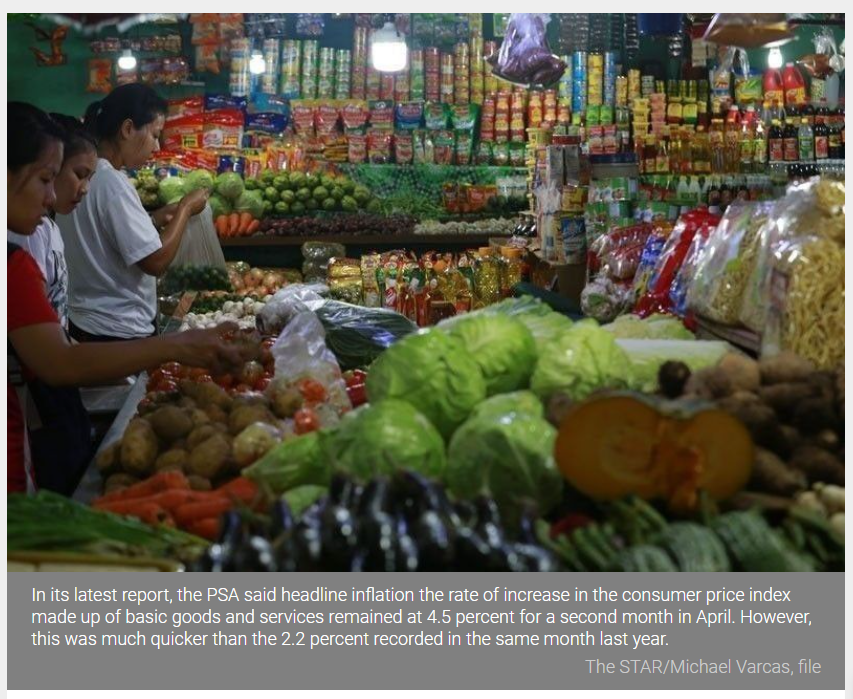Philippines: Inflation steady at 4.5% in April
MANILA, Philippines — Inflation steadied at 4.5 percent in April despite the continued hike in meat prices as this was offset by lower costs in other food items, the Philippine Statistics Authority (PSA) said.
In its latest report, the PSA said headline inflation the rate of increase in the consumer price index made up of basic goods and services remained at 4.5 percent for a second month in April. However, this was much quicker than the 2.2 percent recorded in the same month last year.
Last month’s inflation was also noticeably lower than the median consensus of 4.7 percent by economists and market analysts.
While the April inflation was well within the 4.2 to five percent forecast of the Bangko Sentral ng Pilipinas for the month, it breached the two to four percent target for 2021. Inflation for the first quarter averaged at 4.5 percent.
The steady inflation in April was largely caused by the lower annual increment in the heavily weighted food and non-alcoholic beverages at 4.8 percent.
However, meat, which is a major contributor in the food category, further accelerated to 22.1 percent from 20.9 percent in March as the lifting of the price cap for pork caused prices to shoot up. Pork inflation in Metro Manila alone went up to 57.7 percent from 51.8 percent.
In a briefing yesterday, National Statistician Dennis Mapa said lower prices of rice, vegetables, fruits and corn offset the hike in meat prices.
“The trend we are seeing in the last four months is that inflation is high but we saw a downturn this April. We will have to monitor if it will continue to decrease,” Mapa said.
“However, meat inflation continues to increase and unless there are interventions, we see that this would continue to go up,” he said.
Union Bank of the Philippines chief economist Ruben Carlo Asuncion said it is likely that inflation for the year would settle and not breach government targets, but the caveat lies in the pace of global economic recovery.
“It is highly likely that we have reached the peak, but I do not want to discount the impact of higher global prices on inflation in the coming months with the global economy gearing up for more economic activities,” he said.
Any acceleration in global economic activity would impact on domestic price levels particularly on oil, with the Philippines relying heavily on the world market for its supply.
Asuncion is also banking on the effectiveness of Executive Order 128 that increases in-quota and slashes tariffs for pork imports crucial to boosting domestic supply.
Nicholas Mapa, senior economist at ING Bank, agreed that upside pressure on inflation remained confined to the supply side, particularly pork and fuel prices.
He said while April inflation marked the fourth month above the BSP’s target as pork and transport costs remain high, “the probability for a breach of five percent is now considerably lower.”
“Inflation will likely dissipate further in May especially if supply side mitigation takes root coupled with weak demand during the MECQ (modified enhanced community quarantine),” Mapa said.
“We will have inflation back within target by June and full year inflation right at four percent by year end,” he said.
Meanwhile, transportation costs, which had a 32.1 percent share to the headline rate, accelerated to 17.9 percent as global prices of crude oil increased which further put pressure on fares for tricycles and jeepneys at 48.4 percent already on the rise because of pandemic-related limitations in carrying capacity.
Retail pump prices also recorded a 32 percent increase.
Also contributing to inflation were increases in the prices in restaurants and miscellaneous goods and services, which had a 9.5 percent share to the headline rate. This was driven by meals, articles for personal hygiene, and barbershop services.
Inflation in the National Capital Region also remained at 3.7 percent. The same trend was observed in areas outside NCR at 4.7 percent.
On the other hand, consumer prices for the country’s poorest households eased as CPI for the bottom 30 percent income households decelerated to 4.9 percent. This brings the year-to-date average to 5.2 percent.
Faster growth of 23.1 percent was seen in the transport index, still an indication of the volatile oil prices in the world market.
Prices of consumer goods for the poorest households outside the NCR went down to 4.9 percent. Inflation in NCR also eased to 4.7 percent from five percent.
With the steady inflation rate for April, Mapa said the BSP is expected to keep rates on hold for the rest of the year to provide support to the economy.
Source: https://www.philstar.com/business/2021/05/06/2096124/inflation-steady-45-april


 Thailand
Thailand




